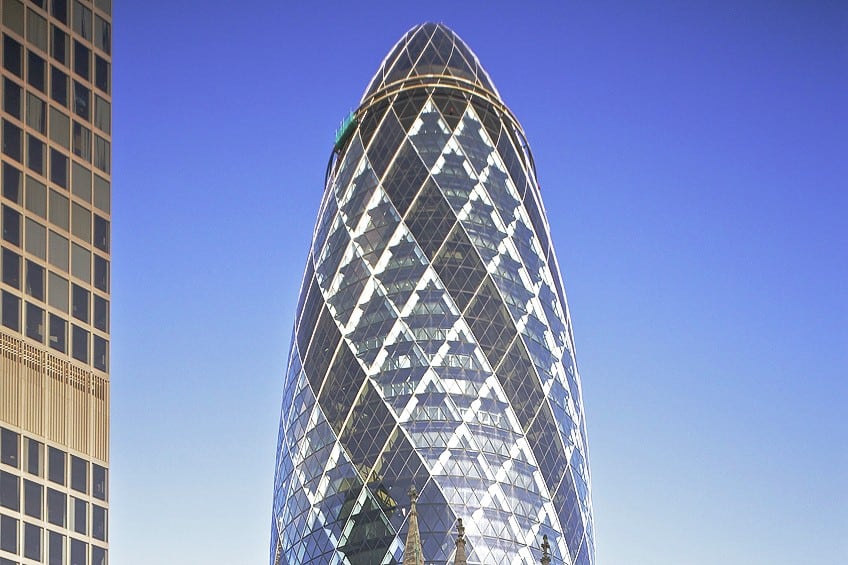Famous Architects – 15 Masters of Form and Function
There have been many architects throughout human civilization, but who are the most famous architects? What makes someone a famous architect? Is it the buildings they designed, the influence that they exerted over architecture as a whole, or the architectural ideas they espoused? There could be many reasons, and we’ll examine those reasons in the following article. So, keep reading to learn more about fifteen of the most famous architects in the world!
Contents
- 1 Fifteen of the Most Famous Architects
- 1.1 Vitruvius (80/70 – 15 BCE) from the Roman Republic
- 1.2 James of Saint George (1230 – 1309) from Savoy
- 1.3 Filippo Brunelleschi (1377 – 1446) from Florence
- 1.4 Donato Bramante (1444 – 1514) from Fermignano
- 1.5 Michelangelo (1475 – 1564) from Florence
- 1.6 Raphael (1483 – 1520) from Urbino
- 1.7 Andrea Palladio (1508 – 1580) from Padua
- 1.8 Thomas Jefferson (1743 – 1826) from Shadwell
- 1.9 Antoni Gaudí (1852 – 1926) from Reus or Riudoms
- 1.10 Frank Lloyd Wright (1867 – 1959) from Richland Center
- 1.11 Walter Gropius (1883 – 1969) from Berlin
- 1.12 Ludwig Mies van der Rohe (1886 – 1969) from Aachen
- 1.13 Le Corbusier (1887 – 1965) from La Chaux-de-Fonds
- 1.14 Frank Gehry (1929 – Present) from Toronto
- 1.15 Norman Foster (1935 – Present) from Stockport
- 2 Frequently Asked Questions
Fifteen of the Most Famous Architects
Below, we will examine fifteen of the most famous architects to have ever lived. Some of them range back to the Classical era, but a few of them are still alive today. So, let’s have a look at some of the most famous architects to have ever lived, why they’re so famous, and why they should be remembered.
Vitruvius (80/70 – 15 BCE) from the Roman Republic
| Architectural Style | Classical architecture |
| Years | 80/70 – 15 BCE |
| Place of Birth | Roman Republic, Italy |
| Known For | De architectura |
Vitruvius is an incredibly important and influential architect because of a text that he produced. This famed architect wrote a book called De architectura. This text then practically vanished off the face of the earth until it was rediscovered around the time of the Renaissance, and the reason this text is so important is that it would lead to the revival of Classical architecture and thereby produce some of the best architecture in the world.
While he is not necessarily known as an architectural designer who directly produced famous structures, he is one of the world’s most famous architects because of his contribution to architecture as a field rather than any individual structures.
This book would serve as the direct inspiration for a number of other architects on this list, and this text is perhaps best known for promoting the idea of every building needing firmitas (or strength), utilitas (or utility), and venustas (or beauty).
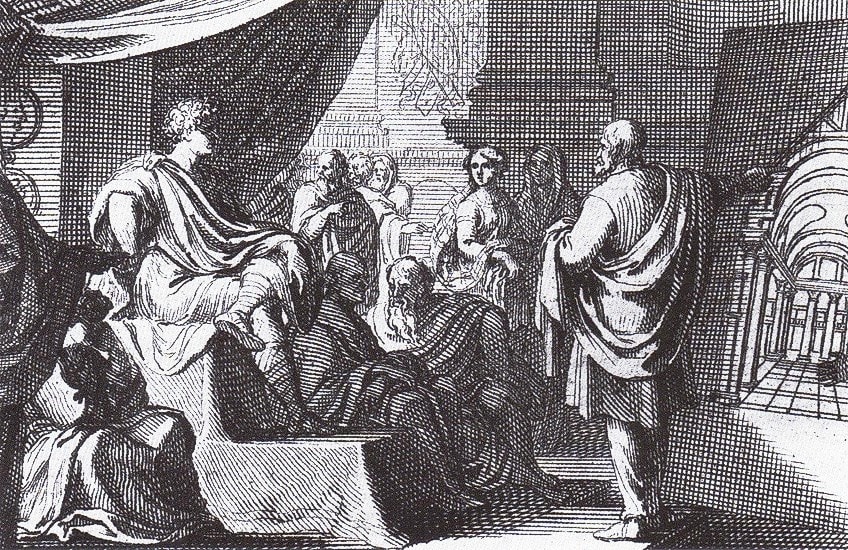
These three primary attributes would go on to spurn the architecture of eras such as the Renaissance and Neoclassical periods. So, Vitruvius, even though we know so little about the man himself other than his early life as an artilleryman and his later life as an architect under Lucius Cornelius Balbus (Julius Caesar’s chief engineer), he has become an incredibly important figure for the development of architecture as a whole. For that reason, Vitruvius is the giant upon which many architects have stood through the centuries.
James of Saint George (1230 – 1309) from Savoy
| Architectural Style | Medieval architecture |
| Years | 1230 – 1309 |
| Place of Birth | Savoy, France |
| Known For | King Edward I’s castles |
James of Saint George was a Medieval mason and architect whose life, for the most part, is rather unknown. Record-keeping during the medieval period was not the main priority of most people, and so we mostly know that he was an architect and that his father was probably an architect and mason too. This is not a lot of information, but we do know that he would go on to considerable fame in his period. He produced some famous architecture in his time as he was the designer of various castles, most notably the castles of King Edward I of England. He started his career constructing and designing a number of works under the Counts of Savoy, but then later drew the attention of the aforementioned English king.
Under Edward I, he built castles in Wales such as those in Harlech, Conwy, and Caernarfon.
His last Welsh castle was Beaumaris. This castle made use of new techniques that were designed by James of Saint George. He developed an outer gate system that was not aligned with the inner gate. This meant that anyone who entered the castle’s outer gate would be forced to travel through an open area that would allow the castle’s defenders to better attack the intruders.
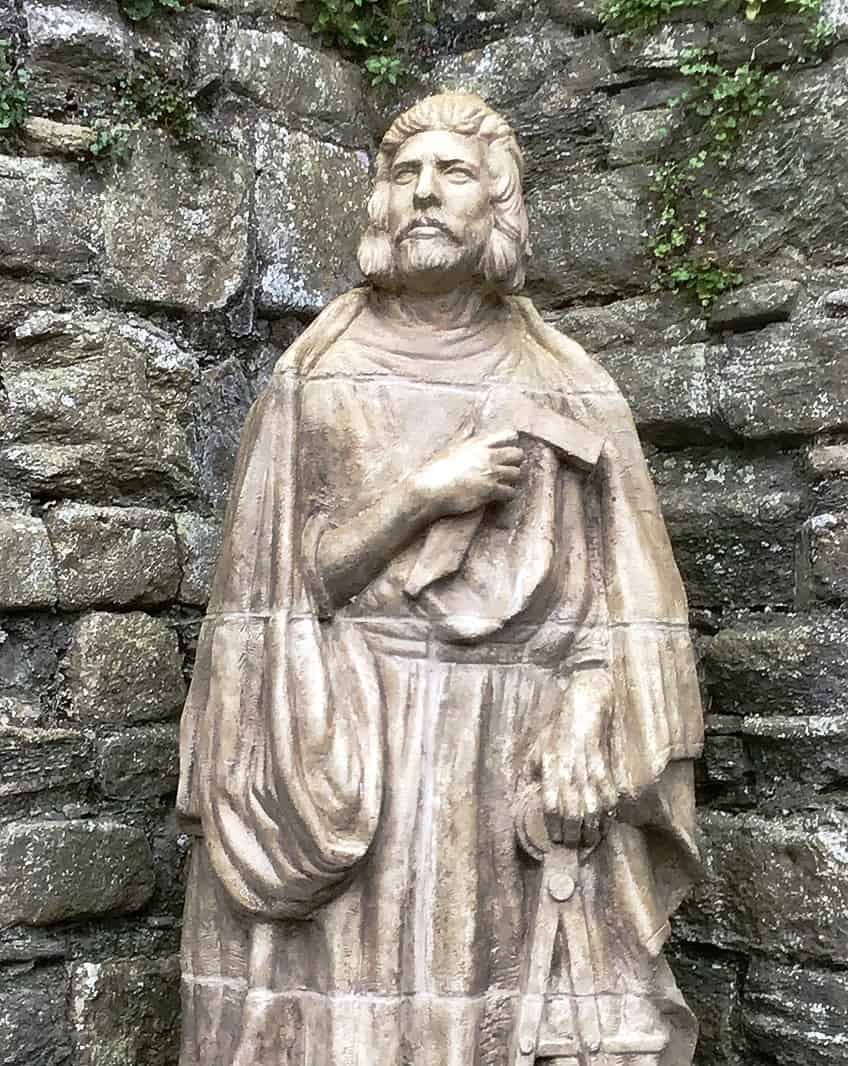
This final castle remained unfinished at the time of his death, and while James of Saint George is not a household name in terms of architectural achievement, he did construct some famous architectural buildings that made use of innovative defensive techniques.
Filippo Brunelleschi (1377 – 1446) from Florence
| Architectural Style | Renaissance architecture |
| Years | 1377 – 1446 |
| Place of Birth | Florence, Italy |
| Known For | Dome of the Florence Cathedral |
Filippo Brunelleschi is one of the founding fathers of Renaissance architecture. He was inspired by Classical architecture and sought to construct his buildings along far more mathematical lines than those that had come before. He is also the first person in the Western world to have received a patent. So, he has a rather interesting history behind him aside from architecture alone. However, when it comes to architecture, Brunelleschi developed new techniques and technologies that allowed for the development of far more impressive feats than those that existed among his contemporaries. For instance, he developed a hoisting machine that allowed for masonry to be more securely placed on a dome.
Through the use of technologies such as this, he was able to create his most famous achievement: the dome of Florence Cathedral.
This dome was the greatest piece of engineering that had been accomplished since the time of the Ancient Romans. This new dome was larger than any that had been constructed since antiquity, but he managed to design and implement this massive dome that is still standing to this day as a symbol of Florence. The dome was ultimately constructed from brick because of its lighter weight and easier maneuverability. His design and technological achievements would go on to influence the remainder of Renaissance architecture.
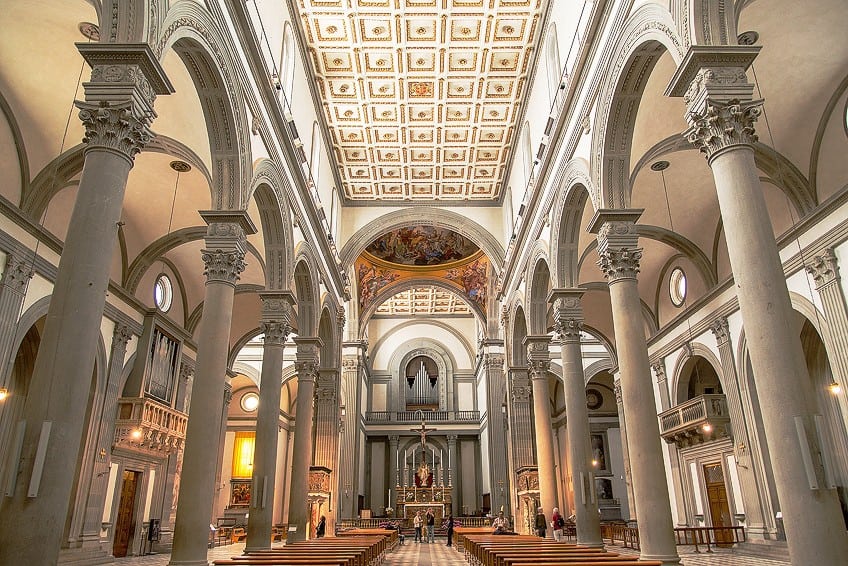
Donato Bramante (1444 – 1514) from Fermignano
| Architectural Style | Renaissance architecture |
| Years | 1444 – 1514 |
| Place of Birth | Fermignano, Italy |
| Known For | St. Peter’s Basilica |
Donato Bramante was both a painter and architect. He was picked up relatively quickly by those in power, such as Pope Julius II, and would be employed as an architect around Italy. He designed many structures throughout the country, especially for papal purposes, but that would not be his eventual claim to fame. Instead, he is best known for being the architect who designed the base structure of St. Peter’s Basilica in Rome.
He was brought on after the construction of the now-famous piece of architecture was stalled for many years.
There had been attempts to get it underway again, but nothing much was happening. He designed the basic plan for the basilica but passed away before it could be properly implemented. However, he is still remembered because Michelangelo, the man who would eventually serve as the primary architect for much of the basilica’s final years of construction, decided to keep the majority of the original plans that Bramante had produced.

Other than his work on St. Peter’s Basilica, Bramante is known as one of the most famous architects from the Renaissance period because of his profound influence on Renaissance architecture in general. He introduced the style to Milan and even brought High Renaissance architecture to Rome. He may be best remembered for his contribution to St. Peter’s Basilica, but he did a lot more than just that.
Michelangelo (1475 – 1564) from Florence
| Architectural Style | Renaissance architecture |
| Years | 1475 – 1564 |
| Place of Birth | Florence, Italy |
| Known For | St. Peter’s Basilica |
Michelangelo is a man best known for things very much other than architecture. The vast majority of people likely don’t even realize that he was also an architect. Instead, most see him as a sculptor and painter. In all likelihood, his most famous work is the ceiling of the Sistine Chapel, which is one of the most famous frescoes in the world, and also his sculpture of David. However, he did a lot more than paint and sculpt. Michelangelo was, within his lifetime, considered so influential that his biography was published during his lifetime (and this would make him the first Western artist to receive this honor), and his achievements have been meticulously documented through the centuries.
He, along with Leonardo da Vinci and Raphael (who will be discussed below), are typically considered to be the three grand Renaissance masters.
Aside from his paintings and sculptures, Michelangelo would go on to work on several structures, such as the façade of the Basilica di San Lorenzo in Florence (which was a Brunelleschi design). However, he is most famous, from an architectural standpoint, for being the most important architect of St. Peter’s Basilica in Rome. He had, as previously mentioned, maintained the original plans of Bramante, but he added his own elements and so the basilica is mostly a Michelangelo design more than anyone else.
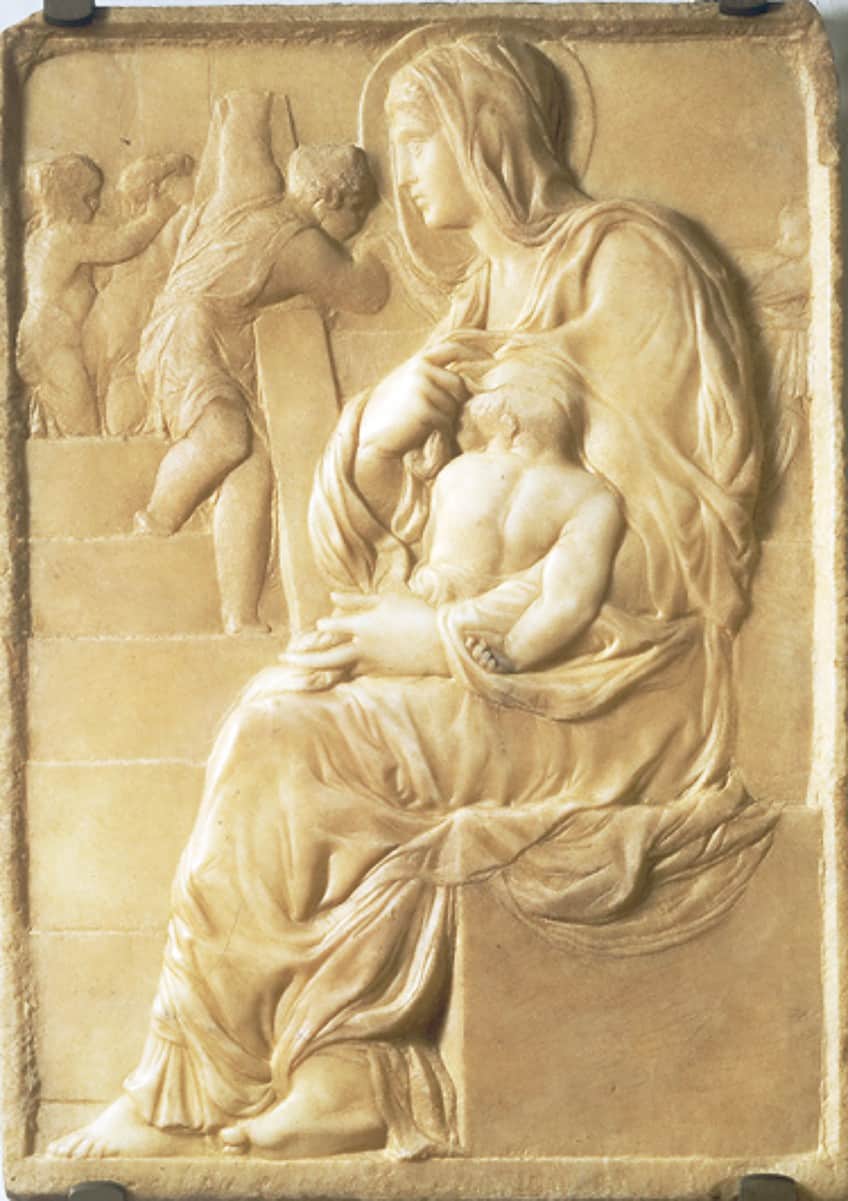
So, not only was Michelangelo an immensely famous painter and sculptor, but also an architect who would design one of the most famous buildings in the Christian world. His work will continue to inspire many for generations, and while he’ll likely never be remembered as an architecture designer in the same way that he’s been remembered for his other accomplishments, his influence has gone on to radiate through the architectural profession for generations.
Raphael (1483 – 1520) from Urbino
| Architectural Style | Renaissance |
| Years | 1483 – 1520 |
| Place of Birth | Urbino, Italy |
| Known For | St. Peter’s Basilica |
Raphael, alongside the aforementioned Michelangelo, was one of the three grand masters of the Renaissance, and in a similar vein to Michelangelo, he is not remembered for his architecture as much as he is for his other works. He became a master at a young age and would travel around Italy for several years before being personally invited to Rome by the Pope. Once there, he received many papal commissions and would become the most important architect in Rome for a short time. He was even appointed, after the death of Bramante, the chief architect of St. Peter’s Basilica. He drew up his own designs for the famous church, but his designs and alterations to the structure would ultimately not survive after Michelangelo became the new architect of the basilica.
However, some of his notes and drawings did remain behind, and his overall design of the structure would have been a lot darker in overall tone than the finished structure.
Raphael may not be all that well-known as an architect, but he is immensely well-known for his other achievements. This means that, by proxy, he became one of the most famous architects in the world who also had a hand in some famous architecture even if his contributions were ultimately discarded.
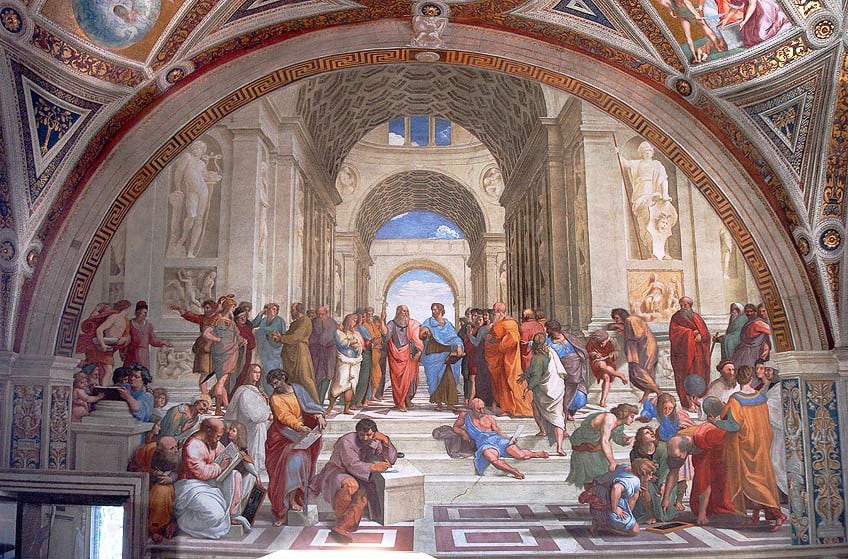
Andrea Palladio (1508 – 1580) from Padua
| Architectural Style | Renaissance/Palladian architecture |
| Years | 1508 – 1580 |
| Place of Birth | Padua, Italy |
| Known For | The Four Books of Architecture |
Andrea Palladio was an Italian architect who was prominent during the Renaissance. However, his fame would only increase after his death as he is not best known for his buildings, but rather for his academic approach to architecture, and his treatise The Four Books of Architecture. This text would go on to influence generations of architects and would spawn Palladian architecture, which was a major influence on Neoclassical architecture in general. Palladio, in terms of his actual architecture, was often in two major forms: villas and palaces. Some of his most famous designs include villas like the Villa Pisani and the Villa Godi. These villas especially exhibit his dedication to a return to Classical techniques. Another of his major achievements was the Basilica Palladiana in Vicenza.
This structure is not a basilica but is called one because the design was meant to evoke images of Roman Basilica structures.
Palladio wanted a return to the Classical era and would make use of arches, domes, and columns in much of his work because of it, and one of his most enduring achievements is the Palladian windows (also known as a Serlian or Venetian window). This window structure is comprised of three parts.

There is a central window comprised of a rounded arched design and on either side of this central window, there are other windows that use a square design. The architectural element is separated through the use of columns or pilasters. This particular technique became a prominent feature in many structures that adopted a Palladian style.
Thomas Jefferson (1743 – 1826) from Shadwell
| Architectural Style | Neo-Palladian architecture |
| Years | 1743 – 1826 |
| Place of Birth | Shadwell, Virginia, United States |
| Known For | Virginia State Capitol |
Thomas Jefferson is another architect, like Raphael or Michelangelo, who was not known for their architecture but rather for their other achievements, but this should not invalidate them as famous architects. Jefferson is, obviously, best known as the third President of the United States and as one of the American Founding Fathers (and he was even the principal author of the Declaration of Independence). However, aside from being a politician and philosopher, he was also a keen lover of Palladian architecture.
He considered architecture to be a passion of his, and he spent much of his life designing his home, Monticello, using Classical techniques.
He believed that the architecture of Ancient Greece and Rome were best suited to the American landscape and that they were the best representatives of American democracy. Through his influence, he popularized Neo-Palladian architecture and even served as an architectural designer on a building that was not his personal residence.

He designed the Virginia State Capitol building using this Neo-Palladian style, and he did all of this without actually studying architecture in any kind of formal capacity. He mostly learned through his readings of Palladio’s primary work The Four Books of Architecture and other aspects of self-study. This may just go to prove that you don’t necessarily need to be formally trained in something if you decide to take an interest in it.
Antoni Gaudí (1852 – 1926) from Reus or Riudoms
| Architectural Style | Catalan Modernist architecture |
| Years | 1852 – 1926 |
| Place of Birth | Reus or Riudoms, Spain |
| Known For | Sagrada Família |
Antoni Gaudí was one of the most revolutionary and famous architects in the world. He was a Spanish architect who designed many structures, mostly in Barcelona, and his work is marked by its extreme individuality and composite style. He did not conform to any particular architectural form and instead adopted a mix-and-match approach that allowed him to produce some utterly gorgeous buildings over the course of his career. The most famous of these is the Sagrada Família.
The Sagrada Família is a still-unfinished church that started construction before he started working on it.
He would then become the primary architect and he spent much of the remainder of his life working on it. Hardly any of it was completed by the time he died, and because this church is entirely privately funded, it has seen many periods of slow or even stagnant construction. It was meant to be completed a century after his death, which would have been in 2026, but the Covid-19 pandemic slowed the construction once again.
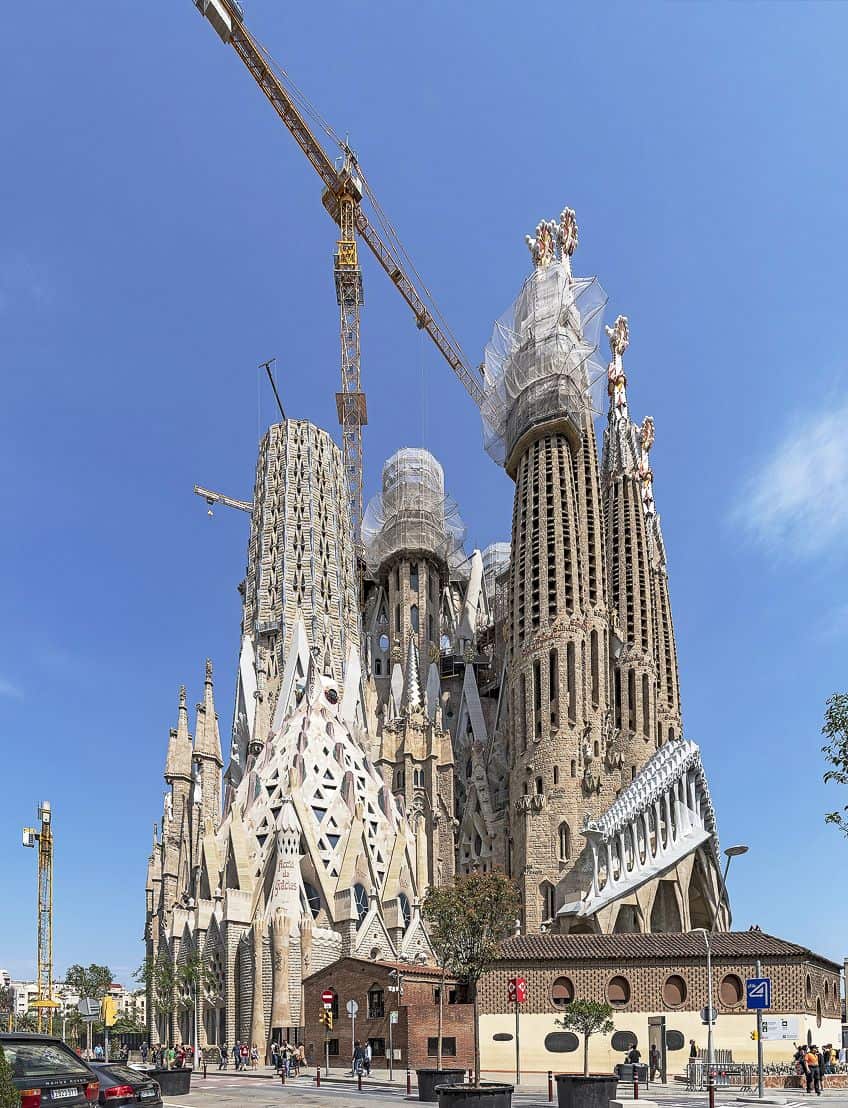
This structure best shows his design capabilities as it is comprised of an eclectic array of architectural styles like Neo-Gothic and Art Nouveau architecture. His work was heavily inspired by the natural landscape around his structures and by his deeply held Catholic faith. These attributes would together lead to Gaudí’s reputation as not only one of the most famous architects in the world but also one of the most unique to have ever lived.
Frank Lloyd Wright (1867 – 1959) from Richland Center
| Architectural Style | Prairie School architecture |
| Years | 1867 – 1959 |
| Place of Birth | Richland Center, Wisconsin, United States |
| Known For | Fallingwater House |
Frank Lloyd Wright was one of the most important figures in Modern architecture. He moved towards a Modern style known as the Prairie School of architecture, which is defined by its attempt to produce an American architecture that evoked the massive and treeless prairie landscapes of the American countryside, and it was also a style that arose from the Arts and Crafts movement. Wright himself has been classified as the greatest American architect by some, and so when it comes to famous American architects, he needs to be listed and discussed.
Over the course of his immensely prolific career, he designed more than a thousand structures and he had a profound influence as an architect but also as an educator and writer on architecture.
His innovative techniques would make him a noted architecture designer across the United States and beyond. He attempted to produce an architectural style, which he called organic architecture, by producing a harmonious connection between the natural landscape and human construction. His most famous building in this style, and also probably one of the most famous residences in the world, is the gorgeous structure known as Fallingwater.
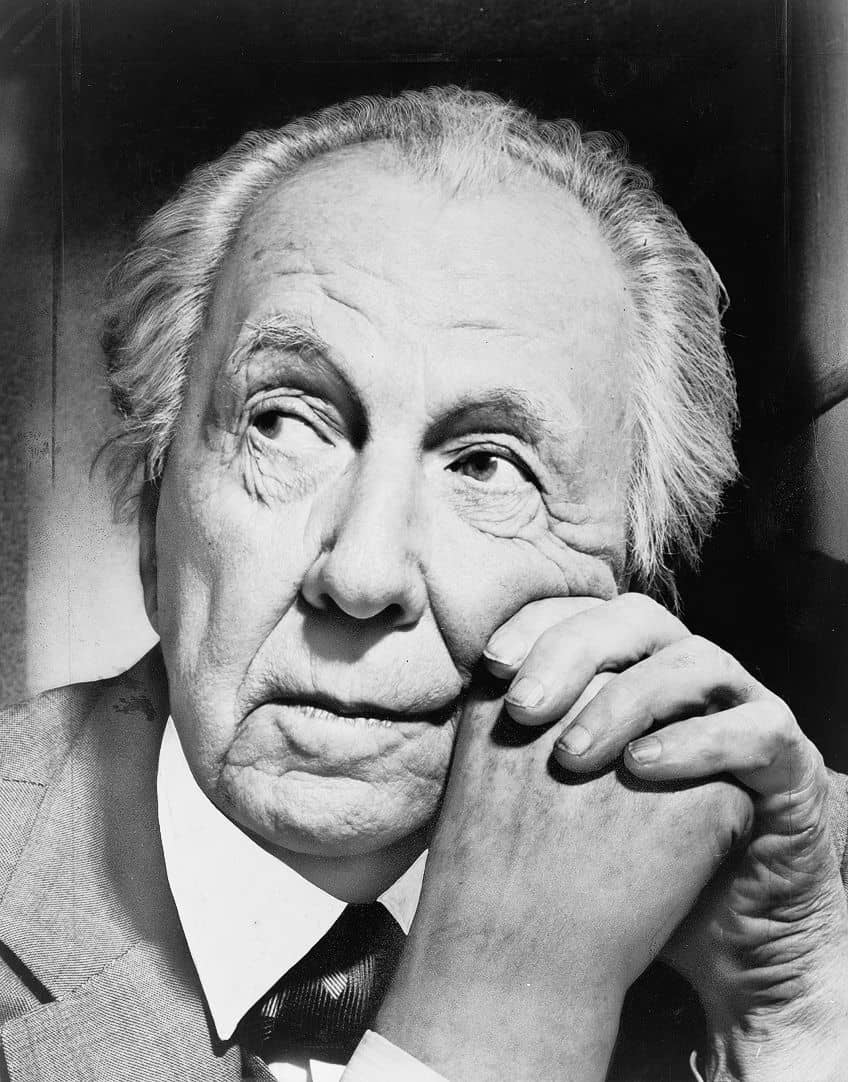
While Wright was always wary of the architectural establishment, he was heavily inspired by his mentor, Louis Sullivan, who was a fellow architect and a major inspiration for the Prairie School. In addition, he was strongly inspired by Japanese art and architecture. His work would synthesize many of his influences into the organic architecture that he promoted. All of this has led Wright to become one of the most famous American architects to have ever lived.
Walter Gropius (1883 – 1969) from Berlin
| Architectural Style | Bauhaus/International Style architecture |
| Years | 1883 – 1969 |
| Place of Birth | Berlin, Germany |
| Known For | The Bauhaus School |
Walter Gropius was one of the pioneers of Modern architecture. He was the founder of the Bauhaus School in Weimar, which led to the development of Bauhaus architecture, which led to further developments in Modern architecture and the more universalized International Style. The influence of Walter Gropius is rather incredible, and while he may not be known for all that many famous architectural buildings, or at least not in comparison to his influence as the founder of the Bauhaus, he did still produce some fantastic structures over the course of his career.
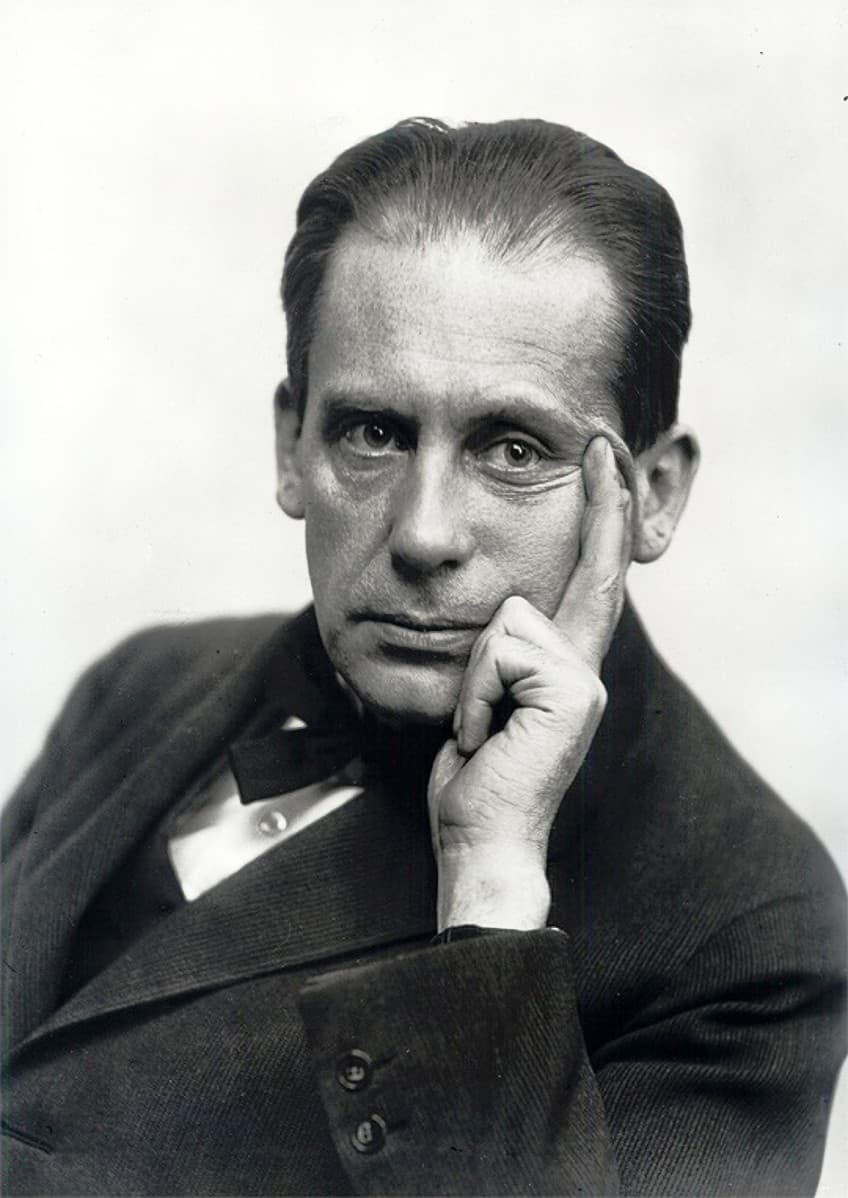
Gropius, along with many other proponents of the Bauhaus School, was forced to flee Germany after the Nazi Party came to power. He settled in the United States and continued to teach a whole new generation of architects the ideas that had been developed in the Bauhaus. His work was characterized by a unity of style in which the structure itself would be complemented by the furniture, interior design, and everything else to do with the structure in general.
Ludwig Mies van der Rohe (1886 – 1969) from Aachen
| Architectural Style | International Style architecture |
| Years | 1886 – 1969 |
| Place of Birth | Aachen, Germany |
| Known For | Seagram Building |
Ludwig Mies van der Rohe was, like Walter Gropius above, a member of the Bauhaus School. He was actually the last director of the Bauhaus but he too was caught up in the Pre-World War Two anti-internationalist policies of the Nazi Party and he was forced to flee the country. He then moved to the United States, as did many such refugees from the Nazis, and he ended up at the Illinois Institute of Technology in Chicago as the head of architecture.

He started his career as a far more traditional architect as he was focused on Neoclassical residences, but he then started to work alongside others to produce a new and avant-garde style. He would eventually become one of the most important individual architects within the Modern architecture tradition. He, for instance, designed the Seagram Building in New York City, which is one of the most influential early skyscrapers in the city because of both its Modern architectural characteristics and its influence on the legislation of the city with regard to the use of public plazas in front of buildings.
Le Corbusier (1887 – 1965) from La Chaux-de-Fonds
| Architectural Style | Modernist architecture |
| Years | 1887 – 1965 |
| Place of Birth | La Chaux-de-Fonds, Switzerland |
| Known For | Villa Savoye |
Charles-Édouard Jeanneret, who is better known as Le Corbusier, was a Swiss-French architect who would go on to become one of the most influential Modernist architects in the world. He designed buildings all around the world and a major aspect of his architectural style could be found in his idea of the “Five Points of Modern Architecture.” These five points involved the use of a grid of reinforced pylons to bear the weight of the structure, the use of an open plan design in which load-bearing walls were used as little as possible within the structure, a façade that is separated from the rest of the structure, horizontal windows to allow large quantities of light to filter through, and the use of a rooftop garden.
The most famous building designed by Le Corbusier that made use of these principles was the Villa Savoye.
Much of his work involved an attempt at providing better living conditions for those living within crowded cities. He became involved in city planning and attempted to produce structures that could be used by regular people. Le Corbusier has become one of the most famous architects to have ever lived, and one of the most influential, because of his contributions to Modern architecture.
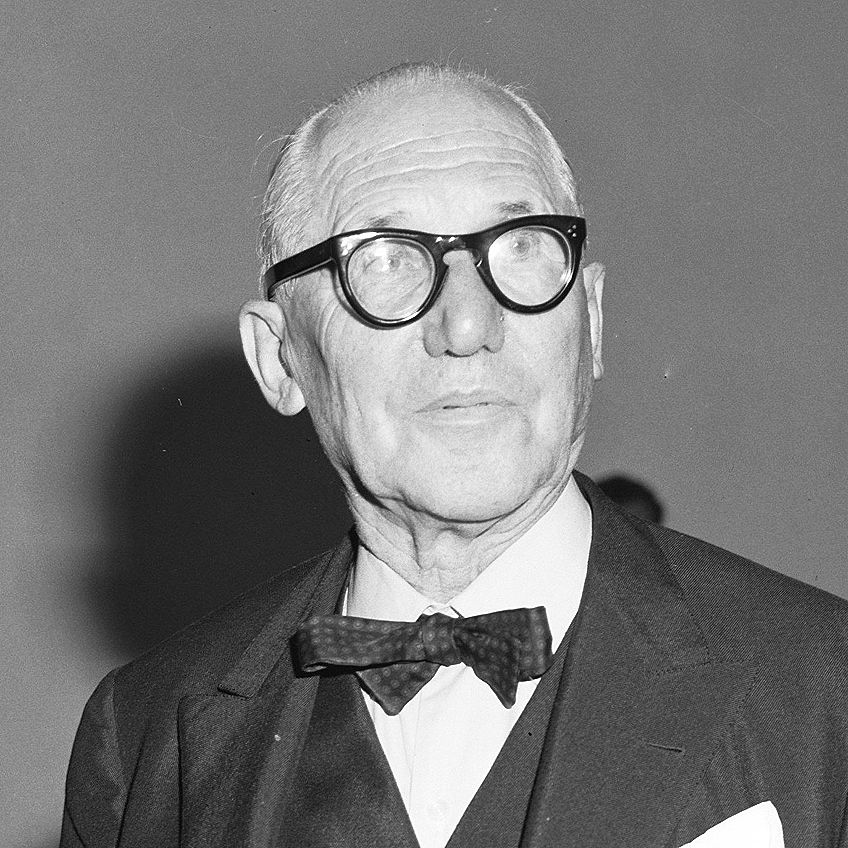
Frank Gehry (1929 – Present) from Toronto
| Architectural Style | Postmodern architecture |
| Years | 1929 – Present |
| Place of Birth | Toronto, Canada |
| Known For | Guggenheim Museum Bilbao |
Frank Gehry is one of the most famous architects in the world, but also one of the most unusual. His work has defined much of contemporary architecture, especially high-end contemporary architecture. His work tends to be immensely flamboyant and generally odd when one first encounters it. Gehry’s work is not easily classified, and while he has often been associated with the Deconstructivist architectural movement, he has denied this label. Either way, he can be broadly placed under the banner of Postmodern architecture in general.
Many of his buildings appear to be somewhat unfinished or include a variety of strange features like metal sheets jutting in various directions.
His most famous building is definitely the Guggenheim Museum Bilbao, but he has created many similarly bizarre structures like the Museum of Pop Culture in Seattle, the Walt Disney Concert Hall in Los Angeles, and the Richard B. Fisher Center for the Performing Arts in New York City. He often uses unusual materials, geometric shapes, and peculiar curvature in his buildings.
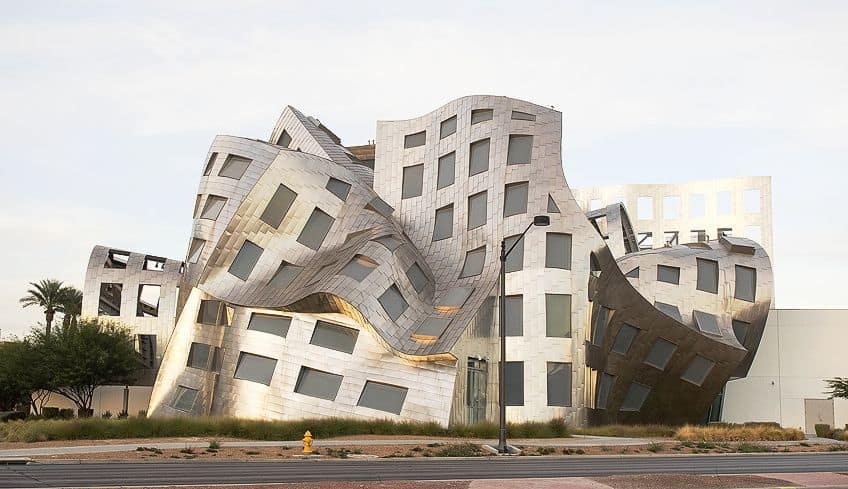
While much of his work has been critically well-received, it has also been accused of being wasteful in its designs in which architectural elements are entirely unnecessary and instead purely aesthetic. His work has also received accusations of being for the ultra-rich, as it is always expensive and generally in service to corporations. Regardless of the criticisms, Gehry’s buildings have become well-known and immensely influential in Postmodern architecture.
Norman Foster (1935 – Present) from Stockport
| Architectural Style | High-tech architecture |
| Years | 1935 – Present |
| Place of Birth | Stockport, United Kingdom |
| Known For | Foster + Partners |
Norman Foster is one of the most famous living architects in the world, but he is also the richest living architect (and probably the richest architect to have ever lived). He did not attain his immensely extravagant wealth solely from the design of structures though. Instead, it comes from his architectural practice Foster + Partners. This practice is one of the largest and most influential in the world. Through his practice and his numerous personal designs, Foster became one of the most important figures in Modern architecture and, more specifically, the high-tech architectural movement. His work is an attempt to create designs that can fit in with the future to become structures that better conform to the contemporary world.
His contemporary architecture has led to his immense fame and wealth.
In fact, Norman Foster was awarded a knighthood and a barony. His full title is Norman Robert Foster, Baron Foster of Thames Bank, OM, RA, HonFREng. He has a number of honors behind his name, and his innovative use of modern materials that directly inspired and aided in the development of British Modern architecture likely means that those honors are well-deserved.
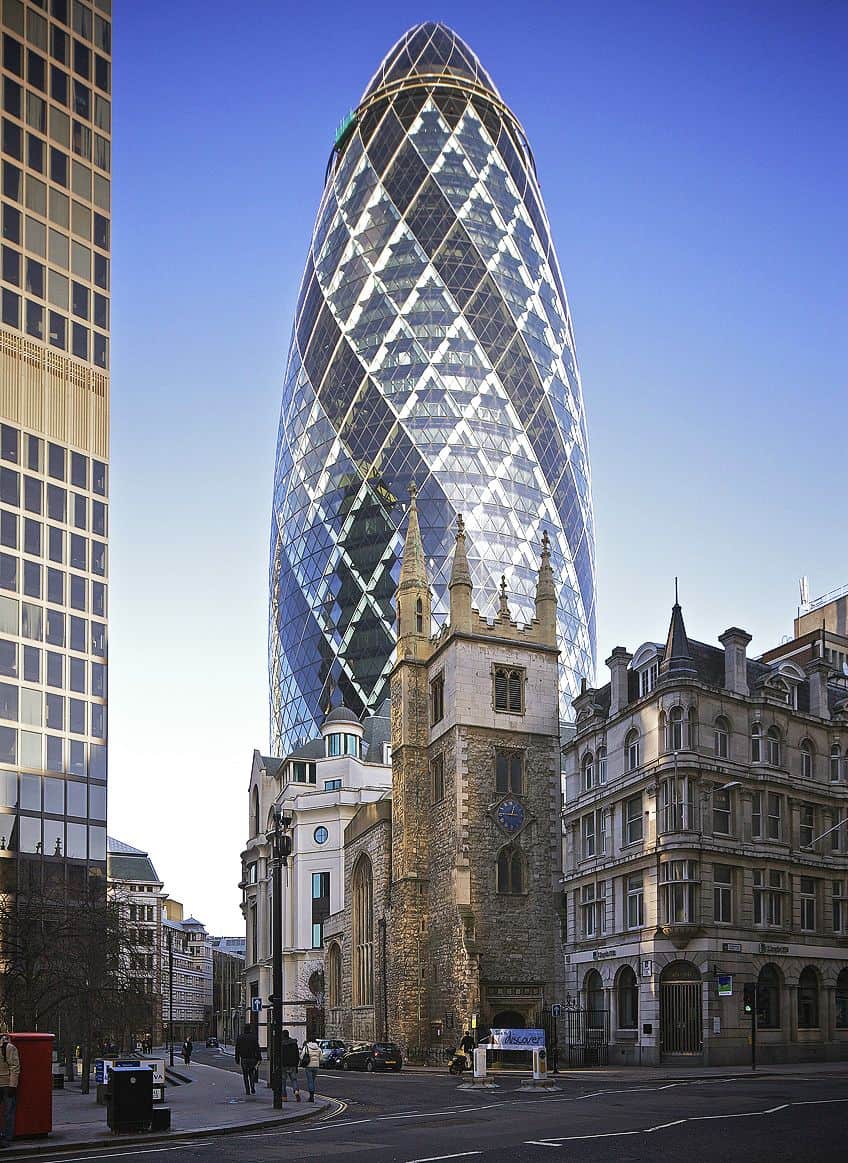
We have come to the end of our look at famous architects. We have examined fifteen different architects who have contributed to some of the best architecture in the world. These architects ranged from the Classical era to the present, and while some of them may not be all that well-known as individuals, their structures certainly are. So, hopefully, you’ve learned a good deal about these famous architects, and all that’s left to say is that we wish you a great day/week/month ahead!
Frequently Asked Questions
Who Is the Most Famous Living Architect in the World?
The most famous architect in the world right now may be Frank Gehry. The idea of a most famous anything is highly subjective, but as Frank Gehry’s postmodern architecture has come to represent much contemporary architecture in general, it makes sense that he may be considered one of the most famous architects in the world. His work is highly unusual and contains fantastical elements that separate it from more traditional architecture, which has caused his work to stand out far more than most.
Who Is the Richest Architect in the World?
The richest architect in the world is Norman Foster, who has a net worth of $240 million. He became so wealthy through his own works, but also because he started Foster + Partners, which is one of the most influential architectural firms in the world. His work is in the realm of contemporary architecture, typically in the high-tech architecture movement, and his firm has gone on to design countless structures over the decades that have contributed to Foster becoming the richest architect in the world.
Who Is the Most Influential Architect in the World?
Influence, like fame, is a difficult thing to measure, but in terms of international architecture, Vitruvius may be the most influential. His work, which was developed in Ancient Rome, was rediscovered during the Renaissance and went on to directly inspired Renaissance and Neoclassical architecture. These styles would then go on to influence every subsequent form, and so the influence continually radiated outwards. His influence is arguable, but he is certainly a good contender for the most influential architect in the world.
Justin van Huyssteen is a writer, academic, and educator from Cape Town, South Africa. He holds a master’s degree in Theory of Literature. His primary focus in this field is the analysis of artistic objects through a number of theoretical lenses. His predominant theoretical areas of interest include narratology and critical theory in general, with a particular focus on animal studies. Other than academia, he is a novelist, game reviewer, and freelance writer. Justin’s preferred architectural movements include the more modern and postmodern types of architecture, such as Bauhaus, Art Nouveau, Art Deco, Brutalist, and Futurist varieties like sustainable architecture. Justin is working for artfilemagazine as an author and content writer since 2022. He is responsible for all blog posts about architecture.
Learn more about Justin van Huyssteen and about us.
Cite this Article
Justin, van Huyssteen, “Famous Architects – 15 Masters of Form and Function.” artfilemagazine – Your Online Art Source. November 6, 2023. URL: https://artfilemagazine.com/famous-architects/
van Huyssteen, J. (2023, 6 November). Famous Architects – 15 Masters of Form and Function. artfilemagazine – Your Online Art Source. https://artfilemagazine.com/famous-architects/
van Huyssteen, Justin. “Famous Architects – 15 Masters of Form and Function.” artfilemagazine – Your Online Art Source, November 6, 2023. https://artfilemagazine.com/famous-architects/.


